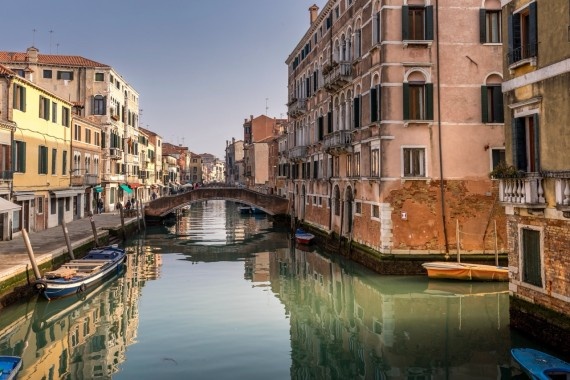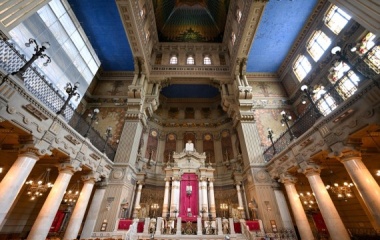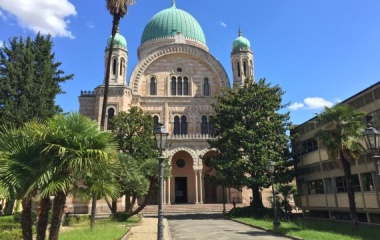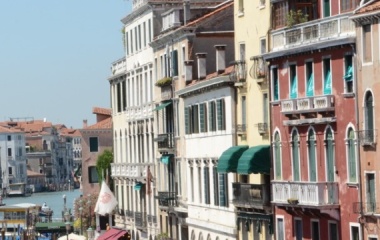
It is hard to imagine a more unique travel destination than Venice. Built on a series of tiny islands connecting one to the other by some 400 bridges, it is a city where the “streets” are made of water and besides walking – Venice spans less than three square miles so walking is a good option – the only way to travel is by boat. It is a refreshing change of pace to take a 25-minute boat ride to the airport.
While it is a beautiful place to visit – and full of Jewish history – it is, as one might imagine, not an easy place to live. Although some 20 million tourists visit annually, only 48,000 people actually live there, fewer than 500 of whom are Jewish. As recently as 1970, 150,000 people live in Venice, and many apartments lay empty.
Yet everything is relative. In pre-modern times it was likely no more difficult to live in Venice than anywhere else – likely easier than most places – thanks to its easy access to the “highways” of the day, the waterways. In the 13th century Venice was the second largest city in Europe and for much of the Middle Ages, a global power.
Venice has had a great impact on Jewish life. It was here that that the first Jewish ghetto was established in 1516. At the time, approximately 700 Jews lived there, reaching a height of 5,000 in the mid 17th century. Unlike many other ghettos the Venetian ghetto was allowed – at least to some extent – to expand to house the growing population. Unlike most ghettos it was not destroyed and looks the same as it did hundreds of years ago. Perhaps surprisingly, there is a rather large open square in the middle of the ghetto. It is because of this space that rabbis were asked to rule if one can play sports on shabbat.
There are five synagogues in the ghetto, all within a couple hundreds of yards of each other – in fact one need not go outside to walk to three of them. Until modern times (and in some Chassidic communities even today) one needed, for good reason, communal permission to open up a shul. With Venice a place where people came from all over with many different customs, the community allowed various shuls so that each major subgroup could maintain its own customs. To this day the Venice shuls are known as the Spanish, Levantine (Greek), Italian, German, and Canton (Provence) shuls.
With five minyanim daily in the medieval period, one of the fascinating community ordinances prohibited any business from opening until the last minyan had finished in the ghetto. It is one thing not to go to minyan, but quite another to engage in business while the competition is busy davening in shul.
Venice was a major centre of Jewish printing. The first complete printed edition of the Talmud Bavli was published here in 1523 by the non-Jewish printer, Daniel Bomberg. With only minor change his pagination remains the standard used today. It is somewhat ironic that a non-Jew is responsible for the fact that it takes seven and a half years to complete a Daf Yomi cycle. More importantly, it was his decision to put the commentary of the Tosafists on the side of the page. This raised the ire of the Maharal of Prague who felt that the dialectical approach on the Tosafists should be studied by advanced students only – its placement on the side was actually a detriment for the proper understating of the Talmud for most. Similarly, the Maharal took the advice of the Sages that one should not study Talmud until the age of 15 seriously, and understood that for most people Talmud studied at too early an age retards one’s growth in Torah.
Bomberg also printed the first edition of the Mikraot Gedolot, the “major” leagues of Torah commentary. There have been many editions using the Mikraot Gedolot name printed over the years – to the best of my knowledge there is no copyright – and the commentaries included reflect the “biases” of the printers[1]. The first edition created much controversy both for substantive reasons and because it was edited by an apostate. Bomberg soon put out a second edition edited by Rabbi Yaakov ben Chaim ibn Adoniyahu, a great scholar who had immigrated from Tunis - who thereafter also became a Catholic, an all too common feature of medieval Jewry. As to having a non-Jew print Jewish classics there was little controversy, for the simple fact that Jews were not allowed to own printing presses[2].
One commentator who, to the best of my knowledge, has been included in pretty much all editions of the Mikraot Gedolot is the Italian Rabbi, Ovadiah Seforno. Like pretty much all Italian rabbis he was well educated in a wide variety of fields – mathematics, philosophy and like so many also trained as a medical doctor. He was a teacher of the Catholic humanist Johann Reuchlin who, the Tiferet Yisrael in his commentary to the Mishna (Pirkei Avot 3:14), names him as one of four examples of righteous of the nations for his defence of the Talmud[3]. For reasons I can only speculate, Seforno, it seems to me, is rarely studied today.
Printing works of such scale involved great expense and inevitably led to disputes. The Maharam Padua, Rav Meir Katzenellenbogen, was chief Rabbi of Padua, Padua being part of the Republic of Venice. He was one of the most prominent of Rabbis of the medieval period and “founder” of a great rabbinic dynasty[4].
In 1550 the Maharam Padua, partnered with Bragadini Press to publish an edition of the Rambam’s Mishneh Torah, including his own commentary. Soon thereafter, a rival printer, Giustiniani Press - which had initially negotiated with Katzenellenbogen – produced a copy of this edition. Having much of the work and expense done by others, they were able to offer the Mishneh Torah at a much lower price. This led to a major dispute culminating with the RaMaH – Rav Moshe Issereles of Shulchan Aruch fame – issuing a ban on the Giustiniani edition. For the next several centuries, the main purpose of haskamot, approbations of rabbinic works, was a copyright ban, declaring a cherem, excommunication, on anyone who would print the book for a specified number of years
Printing in the 16th century was nothing like it is today, and it was the printers who invented “Rashi script” in order to clearly distinguish the text from the commentary. With Rashi being the commentator par excellence, they named this new font, Rashi. In other words, Rashi could not read Rashi script – though I have no doubt he would have learned how to do so very quickly.
[1] The Mikraot Gedolot published by Mosad Harav Kuk in 1993 – The Torat Chaim Chumash – removed the Or Chaim and the Kli Yakar but included Rav Sadayah Gaon, Chizkiun and Radak, the latter having been included in that first edition of Mikraot Gedolot. Looking up the date of publication I noticed the editor was Rav Mordechai Leib Katzenellenbogen, whom I can only assume (but do not know if he) was a descendant of the famous rabbinic family I discuss below.
[2] At least some of the tragic Emden Eybeschütz controversy of the 18th century in which Rav Yaakov Emden accused Rav Yonatan Eybeschütz of being a Sabbatian, was fuelled by the fact that Rav Yaakov Emden owned a printing press.
[3] The other three are Gutenberg for his invention of the printing press, Jenner for the discovery of the smallpox vaccine (smallpox killed approximately 500 million people before widespread vaccination had the disease declared officially eradicated in 1980) and Francis Drake who introduced the potato to Europe. What is fascinating is their merit has nothing to do with their character or level of righteousness but is fully based on their contributions to society.
[4] His descendant Rav Yeckzkel Katzenellenbogen served as Rabbi of Three Communities of Altona, Hamburg, and Wandsbek until 1749 and was succeeded by none other than Rav Yonatan Eybeschütz, leading not long thereafter to the controversy noted above.



